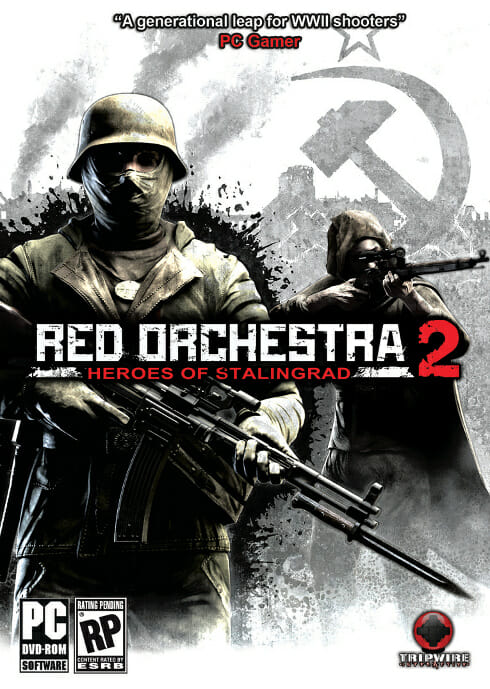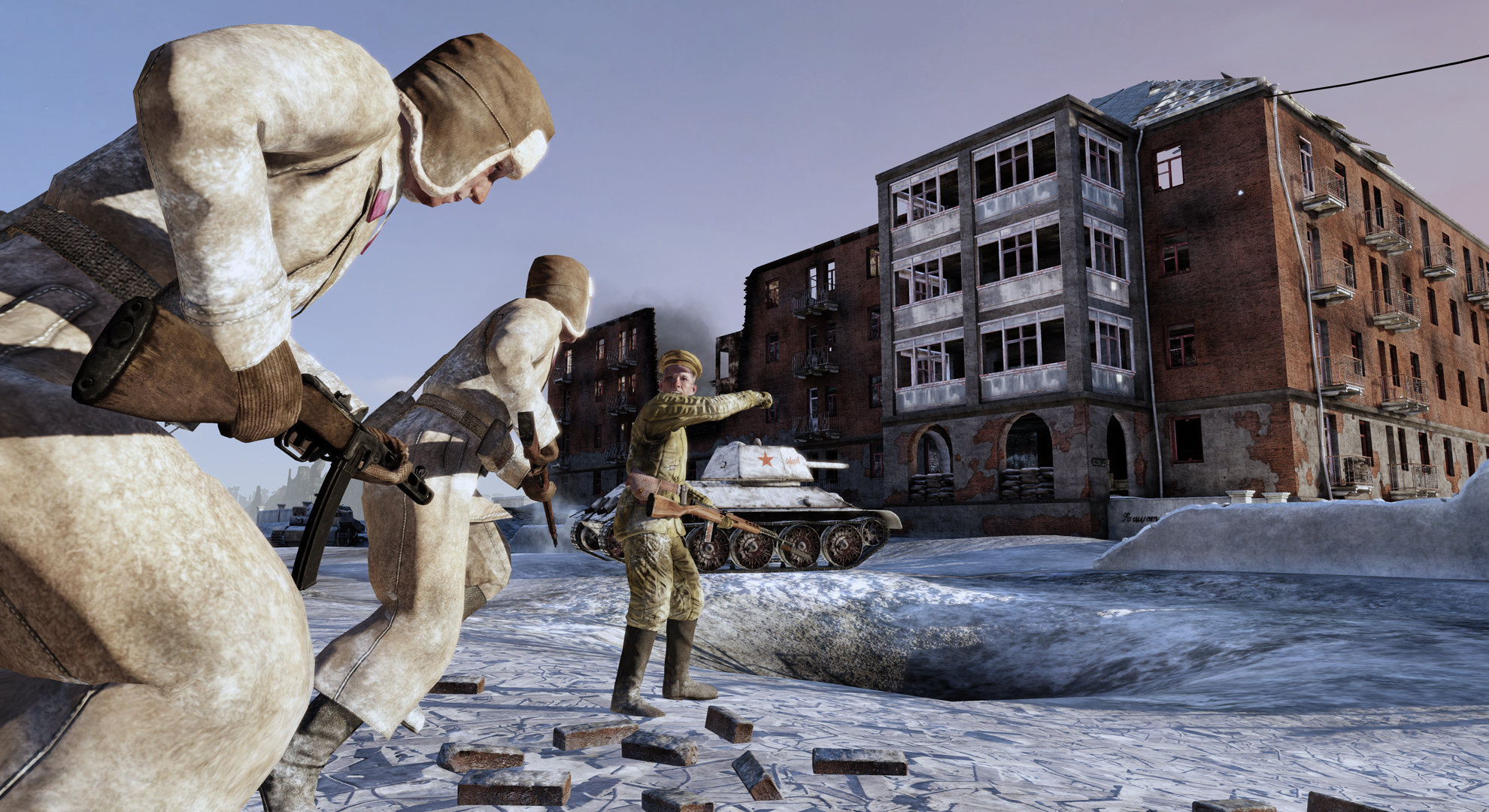
Tripwire Interactive’s realistic shooter focuses on the often overlooked Eastern Front of World War II.
“There is nothing but the rhythm of explosions, more or less distant, more or less violent, and the cries of madmen, to be classified later, according to the outcome of the battle, as the cries of heroes or of murderers. And there are the cries of the wounded, of the agonizingly dying, shrieking as they stare at a part of their body reduced to pulp, the cries of men touched by the shock of battle before everybody else, who run in any and every direction, howling like banshees.” – Unknown German Soldier
Most video games have subtitles that are context-free descriptions or poetic metaphors. Call Of Duty: Modern Warfare? It’s a game about warfare in modern times, as opposed to the World War II settings of other games in the series. Warcraft III: Reign Of Chaos? Some chaotic stuff goes down, and you work to stop it. On the other hand, Red Orchestra 2: Heroes Of Stalingrad has a subtitle soaked in meaning.
It’s a fairly uncontroversial statement to declare that Stalingrad was the greatest battle in human history. It was the turning point of World War II, the widest-scale war in history. The battle involved millions of soldiers, months worth of fighting, and the destruction of a major city. It was also one of the most brutal battles of modern warfare, with first the Russians, then the Germans, defending every building by whatever means were available. The battle didn’t have the elegance of the blitzkreig or Napoleonic cavalry charges. There is no way to hold it up as the model of how how warfare should be conducted aesthetically.

The primitive nature of the battle, as well as the fact that it took place between two vicious, totalitarian nations, means that it’s not often held up as the model of heroism in American culture and gaming. Sure, a few Medal Of Honor and Call Of Duty games have included Stalingrad levels. But they’re not focused entirely on that part of the war. They usually deal with other fronts, including the almost canonically heroic American and British landing on D-Day. Wargames built around historical accuracy have, of course, included Stalingrad, but there’s far fewer of those than there are wargames based on Gettysburg, Waterloo, D-Day, or The Bulge.
Red Orchestra 2 is a historically justified first-person shooter set in the Battle of Stalingrad, because it manages to represent the battle effectively while working as a videogame. This is done holistically throughout the game, with both the presentation and the gameplay combining to achieve this rather impressive goal.
First-person shooters (as well as third-person shooters) have been trending towards cover-based systems for the past decade or so. First, the recharging health meter, triggered by Halo, makes hiding and waiting not simply a viable strategy, but, in many cases, the only workable strategy. Second, that adoption of a dedicated “cover” button to press for hiding behind whatever is available. In some games, this leads to the somewhat absurd situation of lines of crates appearing in whatever room or plaza your characters are fighting in. But in Stalingrad, it makes perfect sense that every block has piles of sandbags, and that every house possesses convenient piles of rubble. Using a dedicated cover button as well as various leans, sprints, crouches and lying prone, the game makes dashing around a broken city work. You’ll desperately dodge machine gun bullets and artillery while trying to get into an apparently safe house. Or you can try to pin down the enemy and sneak around their flanks to negate their defensive advantage. Many games use cover-based combat. Red Orchestra 2 is cover-based combat.

It’s also accurately brutal. Since Counterstrike, another major trend in first-person shooters is to increase the fragility of the player, making self-preservation critical. Red Orchestra 2 amplifies the danger beyond most other games, most likely killing you with a single bullet hit. Surviving two hits is virtually impossible. Individual heroics are occasionally possible – especially in the single-player mode, when the AI occasionally seems to ignore the player – but rarely in multiplayer. You need to work with your squad, or you will fail.
Red Orchestra 2 offers a rigid tweak on conventional squad combat. There are various classes to choose from, as with most similar real-world warfare games, but each of them has set limits. Teams comprised of half-snipers, half-machine gunners are impossible. The bulk of any team is its cannon-fodder riflemen, who tend to get chewed up on the battlefield without machine gun support, smoke grenades, and varied assault patterns. Interestingly, Red Orchestra 2 uses different mechanisms for divvying up squad roles in its single- and multi-player modes. In the former, roles are assigned randomly; you get the chance to choose in the latter, although roles are capped.
This all adds up to a slightly more rigid and less forgiving experience than most similar squad combat games, a feeling that’s entirely appropriate to the setting. This extends even to the equipment used in the game. While many shooters have vehicles like tanks to drive around in and shoot from, they’re usually easy: just point and shoot. Red Orchestra 2 has full tank crews, where the driver, gunners, and commander all have different roles to play, and all have their vision obscured in realistic fashion. The infantry isn’t immune either – gun clips will say how full they seem to be when you reload, but without an ammo counter, you’ll have to rely on memory to know how much is left. And you can run entirely out of ammo, whether in a tank or as infantry, and may have to rely on a teammate for a resupply. It’s not quite so sadistic as to have your guns jam, but if you get stuck in a tank where the tracks have been destroyed and all you can do is drive in circles, you may think it’s plenty sadistic.

The brutality of the battle and its form in the game works through the presentation as directly as it does through the mechanics. The soldiers are essentially faceless, though they do have a bit of personality in the barks they use in combat (and, disturbingly, in their occasional pathetic whimpering deaths). The music is subtle and elegiac, only occasionally and temporarily taking a triumphalist turn at moments of victory. And the Battle of Stalingrad and tenor of the game are occasionally expressed through quotes from diaries of the battle shown at the end of levels, such as one that preceded this review.
While Red Orchestra 2 does manage the impressive feat of making a Stalingrad video game historically respectable, it doesn’t entirely rise above that. In online multi-player, of course, the focus of the game is on individual moments of success instead of grand strategy, but that’s entirely understandable (it also seems to attract a less immature class of player). And the arbitrary nature of victory and defeat in each mission detracts from the tone, though it is necessary.Red Orchestra 2 takes a narrow focus fraught with potential pitfalls, and makes it work by embracing it at every level of its design.
Red Orchestra 2: Heroes of Stalingrad was developed by Tripwire Interactive. It is available on PC.
Rowan Kaiser is a fashionably underemployed freelance writer living the San Francisco Bay Area, and has been published in The A.V. Club, Salon, The Escapist, GamePro, and more. He tweets often @rowankaiser and blogs rarely at renaissancegamer.blogspot.com.